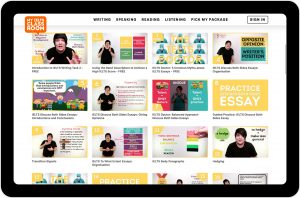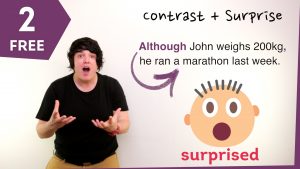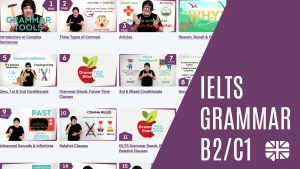
Language for IELTS compare essays
You can guarantee that some point during your IELTS exam, you will need to demonstrate that you can make good comparisons. Interestingly, although the language of comparison is introduced at an Elementary level in most English course books, this is something that many high-level students still struggle with. Today, Nick and describe 4 ways that you can make comparisons in IELTS compare essays, and then show how the same techniques can be used to good effect in the speaking test (which Nick giving a masterful demonstration of how to answer some Part 3 questions)!
Below, you can find a summary of the episode, which includes all of the links to useful materials and the times of each part of the discussion (so you can go directly to the part you want to listen to) 🚀
Subscribe to My IELTS Classroom podcast on Apple podcasts here
Subscribe to My IELTS Classroom on Google podcasts here
Become a Patreon to gain access to extra BONUS episodes here

When you may need to use or understand compare language in the IELTS exam
The ability to make accurate comparisons is a fundamental English skill, so it is no wonder that it is tested throughout the IELTS test. For example, True, False, Not Given questions in the reading often focus on checking if a given comparison is correct. Part 3 of the speaking exam almost always contains at least one question that will ask you to compare ideas or statements (as we will see at the end of the episodes when we put Nick to the test) and any student sitting the Academic version of the test knows that they have a 50% chance of getting a chart that shows either change or comparison.
In today’s episode, however, we are going to focus primarily on how you can make comparisons in IELTS essays. Unlike other tests, although no essay prompt ever asks you directly to “compare and contrast”, this does not mean that there are no IELTS compare essays. On the contrary, there are three common types of essay that will require you to make accurate comparisons:
1 Agree / Disagree essays that are actually IELTS compare essays
These are perhaps the most obvious “IELTS compare essays” because despite asking you to “agree” or “disagree” they directly present you with two opposing options, which must be compared. Take this question for example:
Governments should spend more money on railways than roads. To what extent do you agree or disagree?
Obviously, to answer this well, you will have to weigh up the benefits and drawbacks of both types of investment and compare them directly to decide which is best (and, thus, if you agree or disagree.
2. Discuss Both sides essays that are actually IELTS compare essays
In a similar way, many Discuss Both Sides essays give you absolute opposite views on the same topic. Again, in order to decide which approach is the best, it will be necessary in your discussion to compare them in some way:
Some people say that parents should encourage their children to take part in organised group activities in their free time. Others say that it is important for children to learn how to occupy themselves on their own. Discuss both these views and give your own opinion.
3. Essays that ask you to discuss a recent social change are actually IELTS compare essays
I have become quite obsessed recently with social change essays. That is because they are becoming more and more common but are overlooked by most IELTS teachers. Nick and I spent a whole hour in August explaining what social change essays are and how you can approach them best. If you have’t listened to that episode yet, I strongly recommend that you do so now as it could really save your score for Task Response if you get a similar essay in your test. Just click here.
Today more people are travelling today than ever before. Why is this the case? What are the benefits for the traveller?
Very simply though, a social change essay is one that asks you to look at an emerging trend in society. Most of the time you will be asked why that change is happening and then to comment on whether you think it is a positive or negative one. The key to answering these questions well is to focus on the CHANGE i.e. to consider why this trend is happening more today than in the past.

In other words, you will need to compare people’s behaviour in the past to their behaviour today. For the above question, that will mean not focussing on why people travel a lot today, but why they are travelling more today than in the past. It is considering the change that will lead to a high score.
Click here to watch the first three lessons in our IELTS Writing Course to see the difference that genuine expertise can make to your preparation.

4 Ways to show comparisons in IELTS compare essays
Ways to compare 1 – Use the “contrast” comparison
Our first way to compare is a good one for lower level learners as it does not require any specialist comparison language. All we are going to do is write one sentence describing X and a contrasting sentence describing Y, and join the two sentences using “In contrast”. Let’s look at an example sentence for the the railways / road question:
Railways are an environmentally friendly form of transport, with relatively little carbon emissions per passenger. In contrast, many cars often carry just one passenger and emit not only carbon but other poisonous gases into the atmosphere.
As you can see, this a very straightforward strategy as we are using the present simple in each sentence, but it is still a very effective way of making an argument. Note that in this sentence, we do not use “on the other hand’ as that signpost is usually only used to transition between paragraphs.
If you want to make a shorter comparison, or to make a complex sentence, you can replace “in contrast” with “while” or “whereas”.
Railways are an environmentally friendly form of transport as they can carry hundreds of passengers whereas many cars often carry just one passenger, especially during rush hour.
Now, although the function of “in contrast” and “while” or “whereas” is the same, you cannot just make a one-to-one swap as these are different types of words grammatically. “In contrast” is a transition signal and “while” and “whereas” are subordinators. That means you need to use “while” and “whereas” between TWO clauses not two sentences.
If you are not sure of the difference, please stop reading and go and watch my free video lessons “Three types of Contrast” by clicking here.

Ways to compare 2 – Use the “unlike” comparison
Making simple comparisons using “in contrast” or “while” or “whereas” is a fantastic strategy in the exam, but sometimes these sentences can result in sentences with a problem. Have a look at these three sentences (based on the questions in the introduction) to see if you can spot what the problem with the underlined clause is:
- It can be comfortable travelling long distances by rail whereas in a car it can be tiring for the driver.
- Children who take part in group activities can learn the value of working as a team and how to communicate with other members of the group whereas those who spend time on their own do not have this chance.
- In the past it was expensive to fly to another city, but now it is relatively cheap.
Can you see the issue? All of these sentences make nice comparisons, but there is too much repetition in the second clause. I mean, do we really need to give a long explanation of the “other option” every time?
For example, if you say that travel abroad is expensive, do you really need to say that travel at home is cheap? Surely that is obvious!
In the same way, if you say that children who take part in a group activity learn communication skills, is it really necessary to point out that those who spend time on their own do not? Again, this seems repetitive.
One way to avoid this is to use an “Unlike” phrase to replace the repetitive second clause .
Let me show you how that will work:
- Unlike going by car, it can be comfortable travelling long distances by rail
- Unlike children who spend time on their own, those who take part in group activities can learn the value of working as a team and how to communicate with other members of the group.
- Unlike twenty years ago, now it is relatively cheap to fly to another city.
It is quite simple, isn’t it? We keep the clause that contains the important information (i.e the information that we want to focus on) and replace the repetitive clause with a short one that starts with “like and summarises what we are comparing to. Simple, but VERY effective. This type of comparison earns my gold star recommendation of the day!

Ways to compare 3 – Use comparative adjectives
Now we come to the classic way of comparing – using a comparative adjective. This is the comparison language that we learn from a low level at school, so I don’t want to spend too much time looking at it today (we also have a 35 minute lesson in our IELTS Grammar course that covers this in great detail), but let’s go through the basics here:
- If your adjective has one syllable, you will add -er to the end to make the comparative: bigger / taller / shorter. Note that if your adjective ends in a vowel followed directly by a consonant, you will need to “double” the final consonant: hotter / bigger
- If your adjective has two syllables and ends in “y”, you will move the “y” and add -ier to the end to make the comparative: funnier / luckier / happier. If your adjective has two syllables but does NOT end in “y”, then you will just need to add “more”: more modern / more boring / more tired
- If your adjective has three syllables, you will again just need to add “more”: more expensive / more challenging / more fashionable
We can also add adverbs into these sentences to make our comparisons more precise and (importantly for IELTS) slightly more complex.
If there is a small difference between the two items, we can add “slightly” or “a little”
- Buying a yearly travel pass is only slightly cheaper than buying and running a car.
- Taking a holiday in your own country can often be only a little less expensive than travelling abroad.
If there is a big difference between the two items, we can add “far”, “way”, “a lot”, or “much”:
- Living in the countryside is far healthier than in the city.
- Working at home makes it way easier to have a good work-life balance.
- Travelling by train is far more comfortable than by bus.
- It is much easier to tell a person bad news by text message than face to face.
3 Potential Problems with using comparative adjectives ☠️
1. Be careful when you use “much” that you do not automatically use “more”
Students seem to automatically write “more” when they write “much”. This can cause problems when you are using a “short” comparative adjective that ends in -er. Why? Well, because the “-er” is already making the comparison, so adding an extra “more” means that you are saying “more more”!
- eating in a restaurant is much more expensive than cooking food at home
- going to the theatre is something to enjoy but smartphones have made our movie experience much
morebetter
2. Be careful when you have a list of comparatives that all are in the comparative form.
Another problem can be that students remember the comparative rules for the first item in a list, but then forget them for the second:
- First, houses are often more spacious and
roomy/ roomier than apartments. - Cleaning, repairing and refurbishing apartments is usually easier as they are much smaller and
compact/ more compact than a house.
3. Although you need “than” in the sentence, it is NOT what “compares” on its own!
Take a look back at all of the comparative sentences that I have written in this section. You will notice that they all contain the word “than”. This is a vital component of compare sentences but it DOES NOT make the comparison – it is the adding “-er” or “more” that does this.
- We are getting busy day by day than before
- We are getting busier day by day than before.
In fact, in many sentences, you can omit the “than X” because it is clear from context, but the comparative adjective must remain! For example if we have the phrase ‘day by day” in this sentence, we really don’t need to add “than before” as it is obvious what we are comparing!
- We are getting busier day by day than before
Looking for help with IELTS grammar? We have a dedicated 10-hour course that is specifically designed to show you the structures needed for a 7.0+ Click here to watch the first three lessons for free.
Ways to compare 4 – Use “as + adjective + as” to compare
This is the other classic way to compare. Rather than having to change the adjective to the comparative form, you can simply use it between two “as”:
- Women are as intelligent as men
This form of comparison is designed to show that the two items are EQUAL i.e. there is no difference between the intelligence of men and women. However, I don’t think that many things in life are truly equal, so we often add adverbs to show that there is a difference.
If there is a small difference between the two items, we can add “almost” or “nearly”.
- Eating sugar every day is almost as dangerous as smoking.
- Most teachers are nearly as worried as parents about the problem.
If there is a big difference between the two items, we can add “nowhere near”
- Traditional games are nowhere near as interactive as electronic games.
One common problems in IELTS compare essays ☠️
One mistake that I often see repeated is that students seem to think that all they have to do to compare is add the phrase “compared to” or “as compared to” at the end of a sentence. This is not true! In fact, it is very hard to make a comparison using only the phrase “compared to”, and if this is a phrase that you use often, I would recommend that you forget it and start using one of the four techniques above.
Look at the four sentences below for example. None of them are correct as the students have tried to compare using only “compared to”. Can you change the sentences to be correct? We will give you the answers in the podcast:
- The houses are big compared to the past.
- I would like to bring to your attention the reason as to why children are not visiting the park frequently these days compared to the past.
- People can interact with each other easily as compared to the past.
- Living in the countryside is much fresh compared to living in the city
Bonus! Listen to Nick answer these Speaking Part 3 Compare questions
We all know that there is nothing I like more than making Nick work in a podcast. Today, I thought that we could put his vast experience of IELTS speaking tests to good use by making him answer these questions. How did he get on? You will need to listen to find out!
Is it more enjoyable to do free time activities inside or outside?
Do you think young people and old people have the same attitude to change?
Is it better for a person to show their emotions or to hide them?
Do you think life was better before the invention of the computer?
Do you think living in a nice place is more important than having a good job?
What are the differences between the cause of stress today and in the past?

